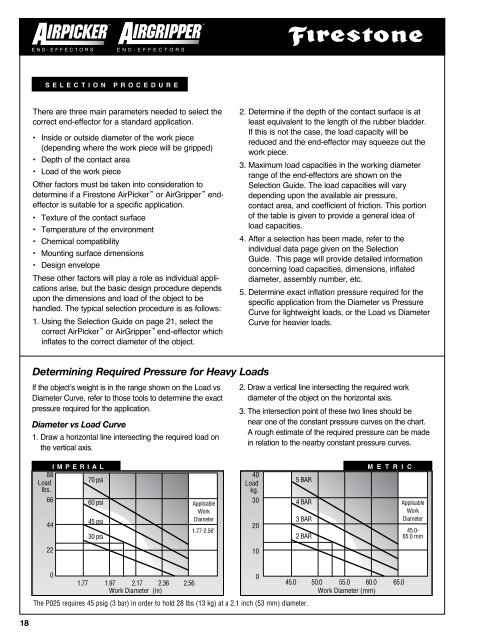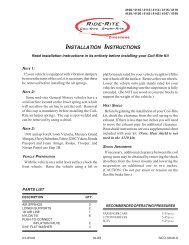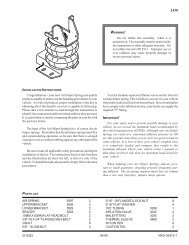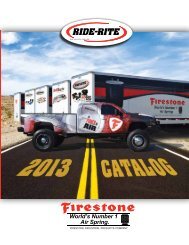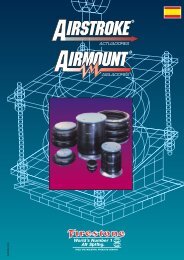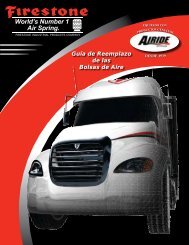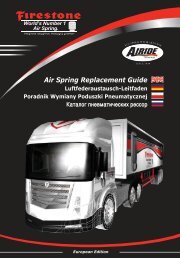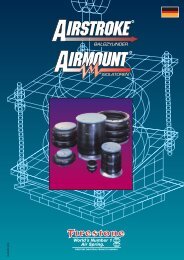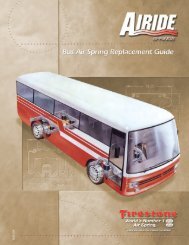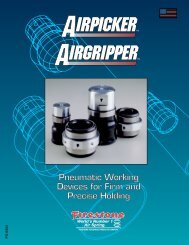G020GCA - Firestone Industrial Products
G020GCA - Firestone Industrial Products
G020GCA - Firestone Industrial Products
Create successful ePaper yourself
Turn your PDF publications into a flip-book with our unique Google optimized e-Paper software.
END-EFFECTORS<br />
END-EFFECTORS<br />
selection procedure<br />
There are three main parameters needed to select the<br />
correct end-effector for a standard application.<br />
• Inside or outside diameter of the work piece<br />
(depending where the work piece will be gripped)<br />
• Depth of the contact area<br />
• Load of the work piece<br />
Other factors must be taken into consideration to<br />
determine if a <strong>Firestone</strong> AirPicker or AirGripper endeffector<br />
is suitable for a specific application.<br />
• Texture of the contact surface<br />
• Temperature of the environment<br />
• Chemical compatibility<br />
• Mounting surface dimensions<br />
• Design envelope<br />
These other factors will play a role as individual applications<br />
arise, but the basic design procedure depends<br />
upon the dimensions and load of the object to be<br />
handled. The typical selection procedure is as follows:<br />
1. Using the Selection Guide on page 21, select the<br />
correct AirPicker or AirGripper end-effector which<br />
inflates to the correct diameter of the object.<br />
2. Determine if the depth of the contact surface is at<br />
least equivalent to the length of the rubber bladder.<br />
If this is not the case, the load capacity will be<br />
reduced and the end-effector may squeeze out the<br />
work piece.<br />
3. Maximum load capacities in the working diameter<br />
range of the end-effectors are shown on the<br />
Selection Guide. The load capacities will vary<br />
depending upon the available air pressure,<br />
contact area, and coefficient of friction. This portion<br />
of the table is given to provide a general idea of<br />
load capacities.<br />
4. After a selection has been made, refer to the<br />
individual data page given on the Selection<br />
Guide. This page will provide detailed information<br />
concerning load capacities, dimensions, inflated<br />
diameter, assembly number, etc.<br />
5. Determine exact inflation pressure required for the<br />
specific application from the Diameter vs Pressure<br />
Curve for lightweight loads, or the Load vs Diameter<br />
Curve for heavier loads.<br />
Determining Required Pressure for Heavy Loads<br />
If the object’s weight is in the range shown on the Load vs<br />
Diameter Curve, refer to those tools to determine the exact<br />
pressure required for the application.<br />
Diameter vs Load Curve<br />
1. Draw a horizontal line intersecting the required load on<br />
the vertical axis.<br />
2. Draw a vertical line intersecting the required work<br />
diameter of the object on the horizontal axis.<br />
3. The intersection point of these two lines should be<br />
near one of the constant pressure curves on the chart.<br />
A rough estimate of the required pressure can be made<br />
in relation to the nearby constant pressure curves.<br />
Imperial<br />
88<br />
Load<br />
70 psi<br />
lbs.<br />
66<br />
44<br />
60 psi<br />
45 psi<br />
30 psi<br />
Applicable<br />
Work<br />
Diameter<br />
1.77-2.56"<br />
40<br />
Load<br />
kg.<br />
30<br />
20<br />
5 BAR<br />
4 BAR<br />
3 BAR<br />
2 BAR<br />
M e t r i c<br />
Applicable<br />
Work<br />
Diameter<br />
45.0-<br />
65.0 mm<br />
22<br />
10<br />
0<br />
1.77<br />
1.97 2.17 2.36 2.56<br />
Work Diameter (in)<br />
The P025 requires 45 psig (3 bar) in order to hold 28 lbs (13 kg) at a 2.1 inch (53 mm) diameter.<br />
0<br />
45.0<br />
50.0 55.0 60.0 65.0<br />
Work Diameter (mm)<br />
18


